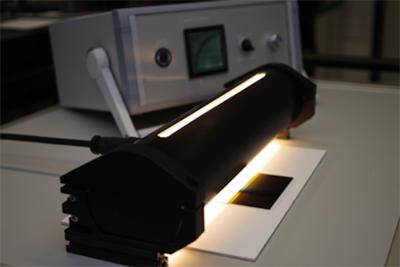A project called NanoQI, funded by the European Union with Horizon 2020 funds, aims to develop an industry-ready, real-time and in-line capable method for characterizing and imaging nano-dimensions of (thin film) nanomaterials in the critical range of 1 to 300 nm on large sample surfaces of more than 500 Ã 500 mm2. The project involves a consortium of eight companies and organizations from five European countries and was initiated on March 1, 2020. The project's mid-term was in September 2021.
 HSI hardware integration and algorithms for automatic quality assessment using HSI, based on XRR/XRD- ground-truth data. (Image: Fraunhofer IWS)
HSI hardware integration and algorithms for automatic quality assessment using HSI, based on XRR/XRD- ground-truth data. (Image: Fraunhofer IWS)
NanoQI combines for the first time X-ray reflectometry (XRR) and X-ray diffraction analysis (XRD) as well as broadband hyperspectral imaging (HSI) into a fast, real-time method for quality control in thin film processing that can be directly integrated into the coating equipment. This combination enables equipment operators to access application-relevant properties such as the thickness of individual layers in a coating system, the solid state structure or even derived functional properties ' such as water vapor permeability ' while the coating is still in progress.
These application areas are nano-crystalline perovskite films for high-efficiency solar cells, transparent conductive layer systems on plastic films for flexible electronics, and large-area atomic layer deposition of dielectric or encapsulation layers. All three systems benefit from in-line quality monitoring and imaging evaluation of the homogeneity and long-term stability of the layer properties.
Upon project mid-term in September 2021, the project partners were able to commission the first instrument prototypes, that were assembled by Bruker AXS (Germany) and Norsk Elektro Optikk AS (Norway) specifically for the requirements of the project. A combined X-ray diffractometer (XRD) and X-ray reflectometer (XRR) has been installed at Fraunhofer FEP in Dresden (Germany). Another XRD unit was integrated into a machine for the production of thin film perovskite solar cells for the first time at the project partner TNO (Netherlands). With these devices, layer thickness and nanometer scale roughness, as well as crystallinity of thin layers or layer stacks can be measured very precisely and at high speed.
The material data obtained in this way will serve as the basis for the generation of optical models for high-resolution HSI analysis of large coated substrate areas. NanoQI relies on the expertise of Fraunhofer IWS (Germany) and Nork Elektro Optikk for the integration of the HSI components as well as the analysis of the large amount of data generated from an HSI measurement.
Machine learning algorithms are being implemented to further accelerate the data analysis and to enable the determination of derived functional properties of the layers from the HSI image data. The HSI camera prototypes will be installed and commissioned at the partners' facilities starting in November 2021. Subsequently, the methods will be tested and further optimized in the operational use of the coating systems.
In the future, the combination of XRD, XRR and HSI integrated into thin film processing machines could significantly simplify quality control and process monitoring in the industrial production.
For example, coating machines could use the NanoQI technology to gather and process large amounts of spatially resolved data about surface properties of the coated substrate in real-time during the deposition process ' displaying even small deviations in an easy-to-evaluate false color image.
This would, for example, enable rapid optimization of the process parameters to achieve the desired layer properties and targeted homogeneity. Likewise, yield in manufacturing is increased because process parameters can be readjusted at an early stage - before the layer properties run out of specification.



